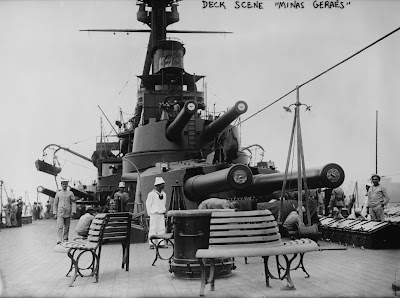"Poor
Mexico! So far from God and so near the United States!" -
Historian
Nemesio Garcia Naranjo.
On
April
9,
1914, in the midst of the Mexican Civil War (with
the U.S. backing revolutionary factions led by Venustiano Carranza),
nine
U.S. sailors
that had gone ashore to buy gasoline in Tampico, Mexico, were
detained for
1h30
by
Mexican
colonel Ramón Hinojosa.
Although the sailors were immediately
freed, and general Morelos Zaragoza
formally
apologized,
U.S.
President
Woodrow Wilson gave the go-ahead for an already planed invasion of
Mexico targeting
Veracruz, the
largest port in that country.
The
ultimate
goal was to overthrow the government of Victoriano Huerta. Meanwhile,
20,000 U.S. Army
soldiers
were being mobilized at the U.S.-Mexican border.

On
April 21-24,
a
mighty
fleet
of 22
U.S.
Navy warships
bombarded
the city and landed 7,000
Blue
Jackets
and
Marines, securing
Veracruz
after five
days of
sporadic
fighting and
seizing $1
million from the Custom House, along
with the cash register of the local administration.
Although unopposed by
Mexican
regulars,
the U.S. officially
lost
22
killed
and 70
wounded, the
Mexicans
had
about
300
killed
and
250 wounded (militia,
students
of the Naval school and civilians).
The
occupation
of Veracruz
would
last
until
November
1914.

This
imperialist show
of force
provoked
anti-American demonstrations throughout Mexico, forcing
tens
of thousands
of U.S. citizens to
cross
the border in haste or to
be evacuated
by U.S.
Navy
ships and given shelter in refugee camps set up in San Diego, Texas,
and New Orleans. Even
revolutionary leader Venustiano
Carranza denounced
the “Second
North American Invasion”
and
called for
war.
Widespread
anti-American riots also broke out in Argentina, Chile, Costa Rica,
Ecuador, Guatemala, and Uruguay.

After
the actions at Veracruz, the U.S. changed their plans from a full
invasion of Mexico, including
taking the capital,
to simply keeping
the city of Veracruz, where
Robert
J. Kerr, a
lawyer from Chicago,
was appointed governor.
Wilson
had him replaced by Major General Frederick Funston who
implemented martial
law and
mandatory vaccinations on the entire population. Keeping
discipline among
the occupation troops
in
a foreign land proved
more delicate:
2,400 U.S. troops were court-martialed, although
only 83 were
convicted.
The
Navy ordered 56
Medals of Honor awarded for “heroism”
for
the brief
Veracruz
Expedition, more than any other military operation
to date! Major
Smedley
Butler demanded that he be allowed to return his, seeing as he had
done little to deserve it. The Navy ordered him not
only to
keep it, but
also
to wear it.
Anti-American
sentiment in Mexico from the Tampico incident and
the Occupation of Veracruz
was the chief reason that the government kept Mexico neutral during
WW1.
President Wilson considered another military invasion of Veracruz and
Tampico in 1917–1918, to take control of the Isthmus of
Tehuantepec, the shortest overland route between the Atlantic and
Pacific oceans, and the Tampico oil fields. In
1916, Wilson also sent a punitive expedition led by General John J.
Pershing deep into Mexico that failed to capture Pancho Villa.


-More
on the topic:
https://www.youtube.com/watch?v=iZQGt83w28Q&t=151s
this
series
https://cimsec.org/100-years-ago-veracruz-1914-part-2/
, https://cimsec.org/100-years-ago-veracruz-1914-part-3/
and
https://www.usni.org/magazines/naval-history-magazine/2014/march/take-veracruz-once
, (in
Spanish):
https://www.google.fr/url?sa=t&rct=j&q=&esrc=s&source=web&cd=&ved=2ahUKEwiO3_O40qHvAhWLERQKHWmqDLc4ChAWMAR6BAgIEAM&url=http%3A%2F%2Fsemar.gob.mx%2Funhicun%2Flibros%2FLa%2520Invasion%2520a%2520Veracruz%2520de%25201914%2520Enfoques%2520Multidisciplinarios.pdf&usg=AOvVaw1kMmw5IJQe0oZW8l4QsDke
See
also Jack London’s photographic Album, Veracruz 1914:
https://hdl.huntington.org/digital/collection/p16003coll7/id/8822/


















